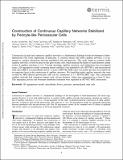Construction of Continuous Capillary Networks Stabilized by Pericyte-like Perivascular Cells
Author(s)
Yamamoto, Kyoko; Tanimura, Kohei; Watanabe, Masafumi; Sano, Hiromu; Uwamori, Hiroyuki; Mabuchi, Yo; Matsuzaki, Yumi; Chung, Seok; Kamm, Roger Dale; Tanishita, Kazuo; Sudo, Ryo; ... Show more Show less
DownloadPublished version (1.613Mb)
Terms of use
Metadata
Show full item recordAbstract
Construction of small and continuous capillary networks is a fundamental challenge for the development of three-dimensional (3D) tissue engineering. In particular, to construct mature and stable capillary networks, it is important to consider interactions between endothelial cells and pericytes. This study aimed to construct stable capillary networks covered by pericyte-like perivascular cells, which maintain the lumen of small diameter similar to that of capillary structures in vivo. Vascular sprouting, capillary extension, and stabilization were investigated using a 3D angiogenesis model containing human umbilical vein endothelial cells (HUVECs) and mesenchymal stem cells (MSCs) in a microfluidic device. A series of HUVEC:MSC ratios was tested; the ratio was found to be an important factor in the construction of capillary structures. We found that stable capillary networks that were covered by MSC-derived perivascular cells can be constructed at 1:1 HUVEC:MSC ratio. The constructed capillary networks had continuous lumens with <10-μm diameter, which were maintained for at least 21 days. This angiogenic process and basement membrane formation were regulated by HUVEC-MSC interactions. Construction of capillary networks is a fundamental challenge for the development of three-dimensional (3D) tissue engineering. However, it is not well understood how to construct stable capillary networks that maintain a luminal size similar to that of capillary structures in vivo (i.e., <10 μm diameter). In this study, we demonstrated the construction of stable capillary networks covered by pericyte-like perivascular cells using an in vitro 3D angiogenesis model by optimizing interactions between endothelial cells and perivascular cells. Our 3D angiogenesis model can be combined with 3D culture of epithelial cells in the context of vascularization of 3D tissue-engineered constructs. Keywords:3D angiogenesis model; microfluidic device; pericytes; mesenchymal stem cells
Date issued
2018-10Department
Massachusetts Institute of Technology. Department of Mechanical Engineering; Massachusetts Institute of Technology. Department of Biological EngineeringJournal
Tissue Engineering Part A
Publisher
Mary Ann Liebert Inc
Citation
Yamamoto, Kyoko et al. "Construction of Continuous Capillary Networks Stabilized by Pericyte-like Perivascular Cells." Tissue Engineering Part A 25, 5-6 (March 2019): 499-510 ©2019, Mary Ann Liebert, Inc.
Version: Final published version
ISSN
1937-3341
1937-335X